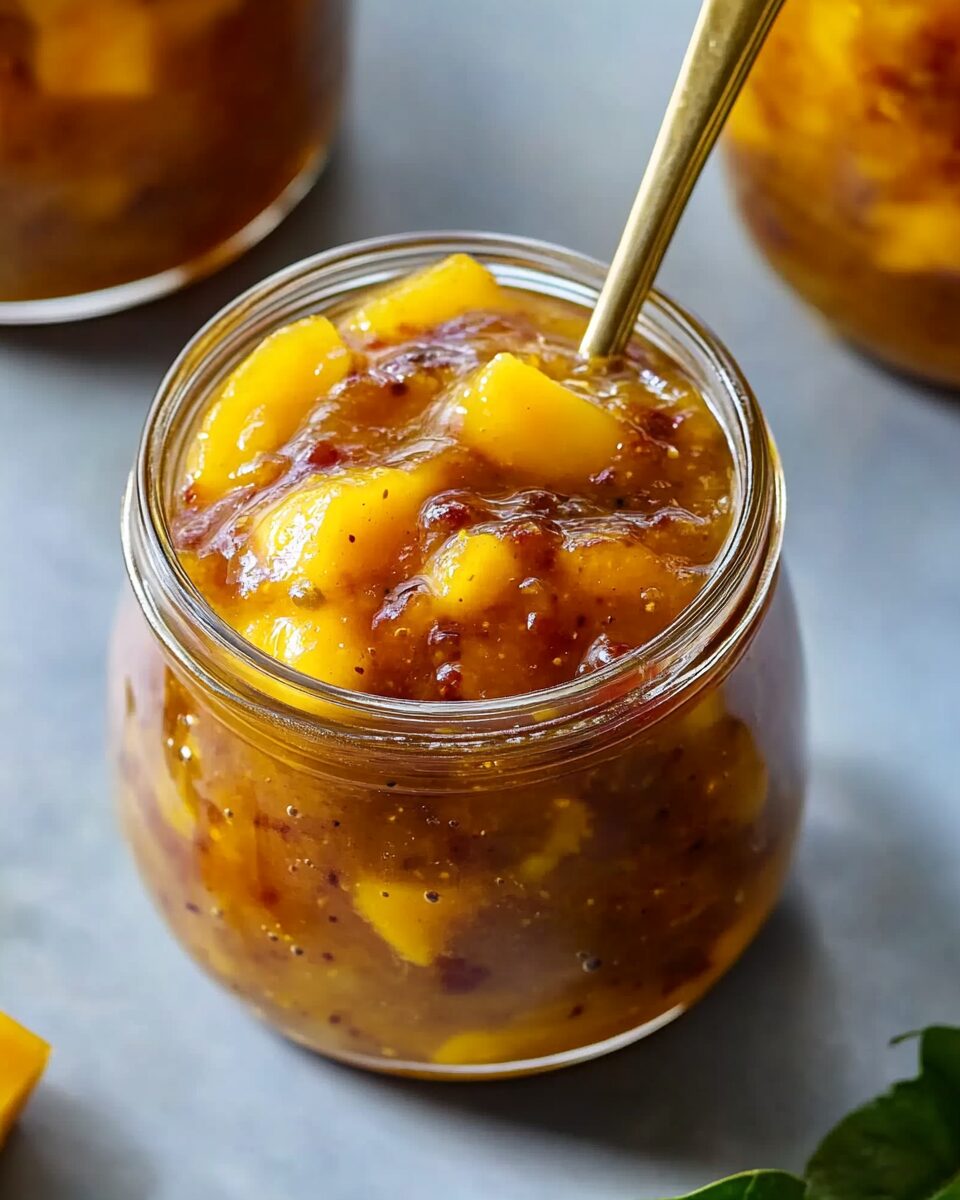Mango Chutney is a flavorful, tangy-sweet condiment that pairs wonderfully with a wide range of dishes. Its combination of ripe mangoes, vinegar, sugar, and a blend of aromatic spices creates a unique and vibrant addition to your meals. This versatile chutney can be used as a topping for grilled meats, a side for curries, or even as a spread for sandwiches and wraps. The fusion of sweetness, heat, and acidity makes Mango Chutney a delightful and exotic accompaniment to both savory and sweet dishes.
Full Recipe:
Ingredients
- 4 ripe mangoes, peeled, pitted, and diced
- 1/2 cup white vinegar
- 1/2 cup brown sugar
- 1/2 cup onions, finely chopped
- 1/4 cup raisins
- 1 tablespoon grated fresh ginger
- 1 teaspoon ground cinnamon
- 1/2 teaspoon ground cloves
- 1/4 teaspoon ground allspice
- 1/2 teaspoon salt
- 1/4 teaspoon red pepper flakes (optional)
- 1/4 cup water
Directions
- In a large saucepan, combine the mangoes, vinegar, sugar, onions, raisins, ginger, cinnamon, cloves, allspice, salt, red pepper flakes (if using), and water.
- Bring the mixture to a boil over medium heat, stirring frequently.
- Reduce the heat to low and simmer for about 45 minutes, or until the chutney thickens and the mangoes break down.
- Stir occasionally to prevent burning and ensure even cooking.
- Once the chutney has reached a thick consistency, remove from heat and let it cool.
- Transfer the chutney to sterilized jars and seal. Store in the refrigerator.
Nutrients
- Calories: 50 kcal per tablespoon
- Fat: 0g
- Carbohydrates: 13g
- Fiber: 1g
- Sugar: 11g
- Protein: 0g
- Sodium: 110mg
The History and Cultural Significance of Mango Chutney
Mango Chutney has deep roots in Indian cuisine, where chutneys of all kinds have been made for centuries. The word “chutney” itself comes from the Hindi word “chatni,” meaning “to lick”—a fitting name given how irresistible these flavorful condiments can be. Traditionally, Indian chutneys were made with various fruits, vegetables, and spices, each region developing its own unique variations based on locally available ingredients.
Mangoes, being native to South Asia, became a popular ingredient in chutneys, particularly because they could be used both in their unripe, tart form and their ripe, sweet form. Green mango chutneys tend to have a sour and spicy flavor, while ripe mango chutneys, like the one discussed here, highlight the fruit’s natural sweetness, balancing it with acidity and warm spices.
During British colonial rule in India, Mango Chutney was introduced to European cuisine and quickly became a beloved condiment in the UK. The British adapted the recipe to their tastes, often making it sweeter and milder than traditional Indian versions. This Westernized version became a staple in British households, frequently paired with meats, cheese, and bread. Today, Mango Chutney is enjoyed worldwide and is often used as a fusion ingredient in different culinary traditions.
Why Mango Chutney is a Versatile and Essential Condiment
One of the best things about Mango Chutney is its versatility. It serves as a multi-purpose condiment that pairs well with a variety of dishes, enhancing their flavors with its sweet and tangy notes. Whether you’re using it as a dipping sauce, a spread, or a cooking ingredient, Mango Chutney adds depth and excitement to your meals.
Ways to Enjoy Mango Chutney:
- As a Side for Indian Curries: Mango Chutney is commonly served alongside Indian curries, such as chicken tikka masala, butter chicken, or lentil dal. The sweetness of the chutney helps balance out the heat from spicy dishes, creating a well-rounded flavor experience.
- With Grilled Meats: Mango Chutney makes a fantastic glaze or dipping sauce for grilled meats like chicken, lamb, or pork. The caramelized sugars in the chutney enhance the smoky flavors of the meat, making every bite more flavorful.
- Paired with Cheese and Charcuterie: This chutney is an excellent addition to cheese boards, pairing beautifully with sharp cheeses like cheddar, brie, or gouda. The contrast between the sweet chutney and the salty, creamy cheese creates a delightful combination.
- As a Sandwich Spread: Instead of using regular condiments like mustard or mayonnaise, try spreading Mango Chutney on sandwiches or wraps. It adds a unique, fruity twist that works especially well with turkey, ham, or grilled cheese sandwiches.
- Mixed into Salads or Dressings: A spoonful of Mango Chutney can elevate a simple salad by adding sweetness and depth of flavor. It can also be blended into dressings for an exciting tropical touch.
- As a Dip or Appetizer: Serve Mango Chutney as a dip for samosas, spring rolls, or crispy flatbreads. Its sweet and spicy nature complements fried foods perfectly.
The Health Benefits of Mango Chutney
In addition to its delicious taste, Mango Chutney offers several health benefits, mainly due to the nutrient-dense ingredients used in its preparation. While chutneys often contain sugar, they still retain the natural goodness of mangoes and other wholesome ingredients.
- Rich in Vitamins and Antioxidants: Mangoes are packed with vitamins A and C, both of which play crucial roles in maintaining a strong immune system, promoting healthy skin, and supporting eye health. The antioxidants in mangoes help fight free radicals, reducing inflammation and protecting the body from oxidative stress.
- Aids Digestion: The combination of spices like ginger, cinnamon, and cloves in Mango Chutney aids digestion by stimulating digestive enzymes. Additionally, vinegar helps regulate stomach acid levels, making chutney beneficial for gut health.
- Supports Heart Health: Mangoes contain fiber and potassium, both of which contribute to heart health by promoting healthy cholesterol levels and reducing blood pressure. The use of vinegar in chutneys also supports cardiovascular health by helping regulate blood sugar levels.
- Anti-Inflammatory Properties: Many of the spices in Mango Chutney, such as ginger and cloves, have anti-inflammatory properties that can help reduce joint pain, improve circulation, and support overall well-being.
Tips for Making and Storing Mango Chutney
Making Mango Chutney at home is a simple and rewarding process, but a few tips can help ensure the best results:
- Choose Ripe Mangoes: For a naturally sweet chutney, select ripe, juicy mangoes. If you prefer a more tart flavor, you can mix in slightly under-ripe mangoes.
- Balance Sweetness and Acidity: Adjust the sugar and vinegar levels to achieve the perfect balance of sweetness and tang. Too much sugar can make the chutney overly sweet, while too much vinegar can make it too sharp.
- Simmer for the Right Consistency: Cooking the chutney at a low simmer allows the flavors to meld together and the mixture to thicken properly. Stir occasionally to prevent sticking or burning.
- Proper Storage: Store Mango Chutney in sterilized jars for long-term preservation. If properly sealed, it can last for months in a cool, dark place. Once opened, keep it refrigerated to maintain freshness.
Conclusion
Mango Chutney is a delightful, multi-purpose condiment that brings an explosion of flavor to any dish. With its perfect balance of sweetness, tanginess, and spice, it has become a beloved addition to meals across various cultures. Whether enjoyed as a side for curries, a topping for grilled meats, or a spread for sandwiches, Mango Chutney adds a vibrant touch to everyday dishes






